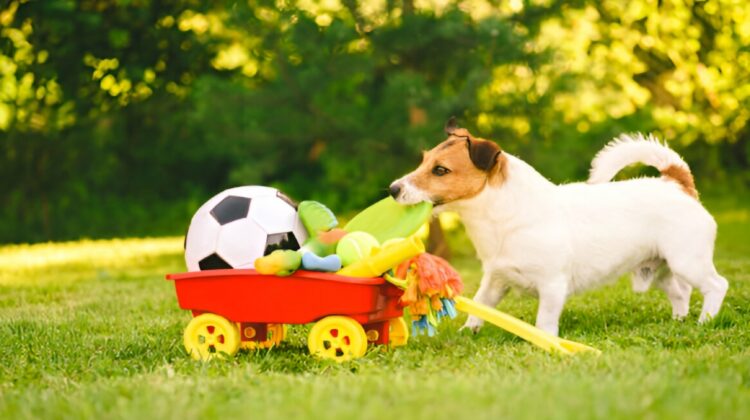
Interactive toys for dogs have become increasingly popular among pet owners who are looking to provide their furry friends with mental stimulation and enrichment.
These toys offer more than just entertainment; they engage a dog’s mind and promote cognitive development in a fun and engaging way. In this article, we’ll explore the importance of cognitive development in dogs and introduce you to three of the best interactive toys designed to enhance your dog’s cognitive abilities.
Understanding the Importance of Cognitive Development in Dogs
Cognitive development refers to the growth and maturation of mental processes in dogs, including learning, problem-solving, memory, and perception. Just like humans, dogs benefit greatly from mental stimulation and exercise. Engaging in activities that challenge their cognitive abilities can help keep their minds sharp, prevent boredom, and reduce the risk of behavioral issues such as anxiety and destructive chewing.
How to Select Interactive Toys for Cognitive Development
When choosing interactive toys for your dog’s cognitive development, consider the following:
- Complexity Level: Opt for toys that offer varying levels of difficulty to keep your dog challenged as they progress.
- Multi-Sensory Features: Look for toys that engage multiple senses, such as toys with hidden compartments, textures, or scents.
- Safety and Durability: Ensure the toy is made of safe materials and can withstand your dog’s chewing and play habits.
3 Best Interactive Toys That Develop a Dog’s Cognitive Abilities

let’s explore three of the best interactive toys that can help develop a dog’s cognitive abilities:
Toy #1: Interactive Puzzle Feeders
Interactive puzzle feeders are excellent toys for stimulating your dog’s cognitive abilities while also providing them with a rewarding feeding experience. These toys typically require your dog to solve a puzzle or manipulate parts of the toy to access their food or treats. The challenge of figuring out how to extract the treats engages your dog’s problem-solving skills and keeps them mentally stimulated.
Description of the Toy: Interactive puzzle feeders come in various shapes and sizes, but they all share the same basic concept: they require your dog to work for their food. Some puzzle feeders have compartments that your dog must open by sliding or flipping parts of the toy, while others require your dog to spin or roll the toy to release the treats.
How It Enhances Cognitive Abilities: Interactive puzzle feeders encourage your dog to use their problem-solving skills and cognitive abilities to access their food or treats. By engaging in activities that require mental effort, your dog’s cognitive abilities will be strengthened over time. Additionally, puzzle feeders can help slow down your dog’s eating pace, promote better digestion, and prevent obesity.
Toy #2: Interactive Learning Games
Interactive learning games are designed to challenge your dog’s cognitive abilities while providing them with a fun and engaging experience. These games often involve tasks such as matching shapes, pressing buttons, or navigating obstacles to receive a reward. By encouraging your dog to engage in problem-solving tasks, interactive learning games help improve their memory, attention span, and overall cognitive function.
Description of the Toy: Interactive learning games come in a variety of designs, from simple puzzle boards to more complex electronic games. Some games require your dog to press buttons in a specific sequence to release treats, while others involve hiding treats under movable tiles or compartments.
Cognitive Benefits for Dogs: Interactive learning games provide your dog with mental stimulation and encourage them to use their cognitive abilities to solve problems and complete tasks. By engaging in these games, your dog will improve their memory, spatial awareness, and decision-making skills. Additionally, interactive learning games can help prevent boredom and reduce anxiety by providing your dog with a mentally stimulating activity.
Toy #3: Interactive Treat Dispensers
Interactive treat dispensers are a fun and rewarding way to engage your dog’s cognitive abilities while also providing them with tasty treats. These toys typically dispense treats when your dog performs a specific action, such as pressing a button or pulling a lever. By associating their actions with a reward, your dog learns to problem-solve and use their cognitive abilities to earn treats.
Overview of the Toy: Interactive treat dispensers come in various shapes and sizes, but they all function on the same principle: your dog performs an action to release a treat. Some treat dispensers require your dog to push or pull levers, while others involve spinning or rotating parts of the toy to access the treats.
Cognitive Stimulation Features: Interactive treat dispensers provide your dog with mental stimulation by requiring them to use their problem-solving skills to access the treats. By engaging in activities that challenge their cognitive abilities, your dog’s brain will be exercised and strengthened over time. Additionally, interactive treat dispensers can help improve your dog’s focus, attention span, and impulse control.
Tips for Maximizing the Cognitive Benefits of Interactive Toys
To maximize the cognitive benefits of interactive toys for your dog, consider implementing the following tips:
Engaging Your Dog in Playtime
Spend quality time playing with your dog and participating in interactive toy games together. Your active involvement will enhance your dog’s enjoyment of the activity and provide them with additional mental stimulation.
Rotating Toys for Variety
Introduce a variety of interactive toys into your dog’s playtime routine to prevent boredom and keep them mentally engaged. Rotate the toys regularly to maintain your dog’s interest and provide them with new challenges to solve.
Supervising and Rewarding Play
Make sure your dog is supervised while playing with interactive toys to prevent any accidents from occurring. Reward your dog with praise and treats when they successfully complete a task or solve a puzzle, reinforcing positive behavior and encouraging continued engagement.
Conclusion
Interactive toys play a crucial role in developing your dog’s cognitive abilities and providing them with mental stimulation and enrichment. By incorporating aesthetic dog toys like interactive puzzle feeders, learning games, and treat dispensers into your dog’s playtime routine, you can help strengthen their problem-solving skills, memory, and overall cognitive function.
Remember to choose toys that are suitable for your dog’s size, age, and personality, and always supervise your dog during playtime to ensure their safety and enjoyment. With the right interactive toys and a little patience and encouragement, you can help your dog unlock their full cognitive potential and lead a happy and fulfilling life.